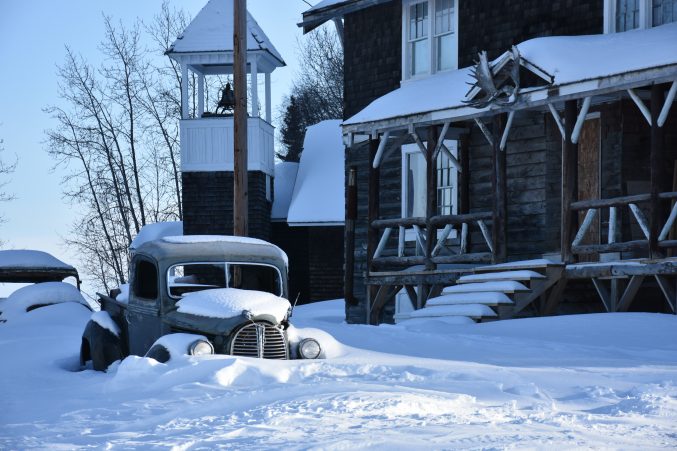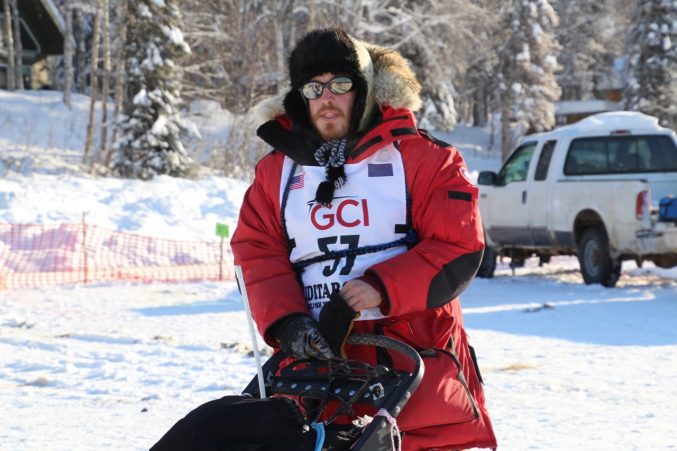- Sleds waiting in UNK
There is a distance of roughly 300 miles from leader to red lantern in Iditarod XLVI. The Back of the Pack has departed Anvik to run north and slightly east on the Yukon River. The front of the pack, having departed Shaktoolik, is on Norton Sound heading pretty much north to the village of Koyuk. Of the sixty mushers between the leader and the red lantern, twenty-six are heading to Kaltag, two are in Kaltag and thirty-two are running between Kaltag and Shaktoolik.
Overnight Unalakleet was busy. After the lead trio departed, seventeen teams arrived to park on the slough and rest for an average of four hours. Those seventeen departed before sunrise Monday morning. Right now Hugh Neff, Michi Konno and Lars Monson populate the checkpoint. They’ll be joined by Martin Buser, Anna Berington, Katherine Keith, Rick Casillo and Cody Strathe later today.
- Anvik Church and dormer Boarding School (Heidi Sloan Photo Credit)
The village of Anvik, situated on the Yukon River is home to Ken Chase. The name Anvik means “exit.” The village population is 86. Anvik is home to the Blackwell School that houses 14 students grades PK-12. The school was named after a very compassionate and respected teacher who challenged and encouraged children. Today, two teachers serve the students of Anvik. The school is very dedicated to preserving the native culture. Students are learning basket weaving and net making from village residents. They are practicing the art of carving Diamon lessons. They’ve produce traditional dance fans used in native dance. When the first musher arrives in Anvik, the bell atop Christ Church is rung. The church was started by missionaries in 1887.
- Bell of Christ Church Tolls for First Musher (Heidi Sloan Photo Credit)
Ken Chase, a life long resident of Anvik, has raced in Iditarod a total of seventeen times. He raced in the inaugural ’73 Iditarod, finishing in 26 days, 11 hours and 45 minutes. Chase returned every year through 1983. After a five-year break he ran five more races. His best time came in 2002, 14 days, 4 hours and 15 minutes, finishing in second to last place. Compare that to recent times of back of the pack finishers using Iditarod archives. Ken was awarded the sportsmanship award in 1977 and also the Golden Harness. At the present, Ken serves on the local school board.
Eighteen miles up river is the village of Grayling with a population of just under 200. The David Lewis Memorial School houses 41 PreK-12 students. The community center that houses the checkpoint has been recently rebuilt incorporating the large beams of the old Community center. The center bears the name of a respected elder, Gabriel H. Nicholi Sr. The cupola that stood atop of the old building adorns the top of the new building. Grayling has a store and a clinic but no restaurant.
- Steve Watkins Departs McGrath
Steve Watkins is out of Anvik (mile 512) on his way to Grayling. Watkins was born in Texas, raised in Kansas and then attended West Point. As a Captain in the U.S. Army, Steve was stationed in Alaska and that’s where he first ran sled dogs. Steve is an accomplished athlete and explorer. In 2015 Steve attempted being the first to run Iditarod and summit Everest in the same year. He completed the Iditarod but at 19,200 feet on Everest, a 7.8 magnitude earthquake struck Nepal. Six people in Steve’s group died on Everest that day. Steve completed his rookie Iditarod run in 12 days, 10 hours and 57 minutes for 58th place.
- Dave Delcourt at Restart
Dave Delcourt is on the trail for his second run to Nome. Running a team of Robert Redington pups, Delcourt has departed Grayling (mile 530) with items from his Eagle Island drop bags. Delcourt attended college in New York the moved to Idaho where his first job was with a Student Conservation Association. Dave began mushing in 2012 and came to Alaska in 2014 to handle dogs for Team Redington. Delcourt says, “I’ve been running dogs for six years and can’t imagine doing anything else.” In his 2017 Iditarod Delcourt finished in 50th place with a time of 11 days, 0 hours and 15 minutes.
- Rob Cooke at Restart
Rob Cooke has also departed Grayling. He’s running a beautiful Siberian team. Cooke currently lives in Whitehorse, YT, Canada. He was born and raised in Worcester, England. Rob spent 23 years in the UK Royal Navy and an aircraft technician and then as an engineering officer. He retired from the Navy in 2005 to live his dream of racing the Yukon Quest with a Siberian team from the kennel he shares with his wife Louise. In 2013, he completed that Quest and was inspired to run both the Quest and the Iditarod in 2015. In doing so, the Shaytaan Siberians became the first purebred team to finish the Distance Double in the same winter. Wanting to prove it wasn’t just luck, they repeated in 2016. Cooke is running his third Iditarod and third Distance Double in 2018. He’s a veteran of five Yukon Quest races.







































